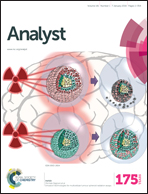Facile multi-dimensional profiling of chemical gradients at the millimetre scale†
Abstract
A vast number of conventional physicochemical methods are suitable for the analysis of homogeneous samples. However, in various cases, the samples exhibit intrinsic heterogeneity. Tomography allows one to record approximate distributions of chemical species in the three-dimensional space. Here we develop a simple optical tomography system which enables performing scans of non-homogeneous samples at different wavelengths. It takes advantage of inexpensive open-source electronics and simple algorithms. The analysed samples are illuminated by a miniature LCD/LED screen which emits light at three wavelengths (598, 547 and 455 nm, corresponding to the R, G, and B channels, respectively). On presentation of every wavelength, the sample vial is rotated by ∼180°, and videoed at 30 frames per s. The RGB values of pixels in the obtained digital snapshots are subsequently collated, and processed to produce sinograms. Following the inverse Radon transform, approximate quasi-three-dimensional images are reconstructed for each wavelength. Sample components with distinct visible light absorption spectra (myoglobin, methylene blue) can be resolved. The system was used to follow dynamic changes in non-homogeneous samples in real time, to visualize binary mixtures, to reconstruct reaction-diffusion fronts formed during the reduction of 2,6-dichlorophenolindophenol by ascorbic acid, and to visualize the distribution of fungal mycelium grown in a semi-solid medium.



 Please wait while we load your content...
Please wait while we load your content...